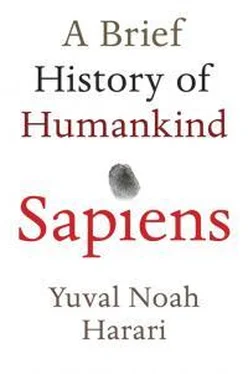The journey of the first humans to Australia is one of the most important events in history, at least as important as Columbus’ journey to America or the Apollo 11 expedition to the moon. It was the first time any human had managed to leave the Afro-Asian ecological system – indeed, the first time any large terrestrial mammal had managed to cross from Afro-Asia to Australia. Of even greater importance was what the human pioneers did in this new world. The moment the first hunter-gatherer set foot on an Australian beach was the moment that Homo sapiens climbed to the top rung in the food chain on a particular landmass and thereafter became the deadliest species in the annals of planet Earth.
Up until then humans had displayed some innovative adaptations and behaviours, but their effect on their environment had been negligible. They had demonstrated remarkable success in moving into and adjusting to various habitats, but they did so without drastically changing those habitats. The settlers of Australia, or more accurately, its conquerors, didn’t just adapt, they transformed the Australian ecosystem beyond recognition.
The first human footprint on a sandy Australian beach was immediately washed away by the waves. Yet when the invaders advanced inland, they left behind a different footprint, one that would never be expunged. As they pushed on, they encountered a strange universe of unknown creatures that included a 200-kilogram, two-metre kangaroo, and a marsupial lion, as massive as a modern tiger, that was the continent’s largest predator. Koalas far too big to be cuddly and cute rustled in the trees and flightless birds twice the size of ostriches sprinted on the plains. Dragon-like lizards and snakes five metres long slithered through the undergrowth. The giant diprotodon, a two-and-a-half-ton wombat, roamed the forests. Except for the birds and reptiles, all these animals were marsupials – like kangaroos, they gave birth to tiny, helpless, fetus-like young which they then nurtured with milk in abdominal pouches. Marsupial mammals were almost unknown in Africa and Asia, but in Australia they reigned supreme.
Within a few thousand years, virtually all of these giants vanished. Of the twenty-four Australian animal species weighing fifty kilograms or more, twenty-three became extinct. 2A large number of smaller species also disappeared. Food chains throughout the entire Australian ecosystem were broken and rearranged. It was the most important transformation of the Australian ecosystem for millions of years. Was it all the fault of Homo sapiens ?
Guilty as Charged
Some scholars try to exonerate our species, placing the blame on the vagaries of the climate (the usual scapegoat in such cases). Yet it is hard to believe that Homo sapiens was completely innocent. There are three pieces of evidence that weaken the climate alibi, and implicate our ancestors in the extinction of the Australian megafauna.
Firstly, even though Australia’s climate changed some 45,000 years ago, it wasn’t a very remarkable upheaval. It’s hard to see how the new weather patterns alone could have caused such a massive extinction. It’s common today to explain anything and everything as the result of climate change, but the truth is that earth’s climate never rests. It is in constant flux. Every event in history occurred against the background of some climate change.
In particular, our planet has experienced numerous cycles of cooling and warming. During the last million years, there has been an ice age on average every 100,000 years. The last one ran from about 75,000 to 15,000 years ago. Not unusually severe for an ice age, it had twin peaks, the first about 70,000 years ago and the second at about 20,000 years ago. The giant diprotodon appeared in Australia more than 1.5 million years ago and successfully weathered at least ten previous ice ages. It also survived the first peak of the last ice age, around 70,000 years ago. Why, then, did it disappear 45,000 years ago? Of course, if diprotodons had been the only large animal to disappear at this time, it might have been just a fluke. But more than 90 per cent of Australia’s megafauna disappeared along with the diprotodon. The evidence is circumstantial, but it’s hard to imagine that Sapiens, just by coincidence, arrived in Australia at the precise point that all these animals were dropping dead of the chills. 3
Secondly, when climate change causes mass extinctions, sea creatures are usually hit as hard as land dwellers. Yet there is no evidence of any significant disappearance of oceanic fauna 45,000 years ago. Human involvement can easily explain why the wave of extinction obliterated the terrestrial megafauna of Australia while sparing that of the nearby oceans. Despite its burgeoning navigational abilities, Homo sapiens was still overwhelmingly a terrestrial menace.
Thirdly, mass extinctions akin to the archetypal Australian decimation occurred again and again in the ensuing millennia – whenever people settled another part of the Outer World. In these cases Sapiens guilt is irrefutable. For example, the megafauna of New Zealand – which had weathered the alleged ‘climate change’ of c .45,000 years ago without a scratch – suffered devastating blows immediately after the first humans set foot on the islands. The Maoris, New Zealand’s first Sapiens colonisers, reached the islands about 800 years ago. Within a couple of centuries, the majority of the local megafauna was extinct, along with 60 per cent of all bird species.
A similar fate befell the mammoth population of Wrangel Island in the Arctic Ocean (200 kilometres north of the Siberian coast). Mammoths had flourished for millions of years over most of the northern hemisphere, but as Homo sapiens spread – first over Eurasia and then over North America – the mammoths retreated. By 10,000 years ago there was not a single mammoth to be found in the world, except on a few remote Arctic islands, most conspicuously Wrangel. The mammoths of Wrangel continued to prosper for a few more millennia, then suddenly disappeared about 4,000 years ago, just when the first humans reached the island.
Were the Australian extinction an isolated event, we could grant humans the benefit of the doubt. But the historical record makes Homo sapiens look like an ecological serial killer.
All the settlers of Australia had at their disposal was Stone Age technology. How could they cause an ecological disaster? There are three explanations that mesh quite nicely.
Large animals – the primary victims of the Australian extinction – breed slowly. Pregnancy is long, offspring per pregnancy are few, and there are long breaks between pregnancies. Consequently, if humans cut down even one diprotodon every few months, it would be enough to cause diprotodon deaths to outnumber births. Within a few thousand years the last, lonesome diprotodon would pass away, and with her the entire species. 4
In fact, for all their size, diprotodons and Australia’s other giants probably wouldn’t have been that hard to hunt because they would have been taken totally by surprise by their two-legged assailants. Various human species had been prowling and evolving in Afro-Asia for 2 million years. They slowly honed their hunting skills, and began going after large animals around 400,000 years ago. The big beasts of Africa and Asia learned to avoid humans, so when the new mega-predator – Homo sapiens – appeared on the Afro-Asian scene, the large animals already knew to keep their distance from creatures that looked like it. In contrast, the Australian giants had no time to learn to run away. Humans don’t come across as particularly dangerous. They don’t have long, sharp teeth or muscular, lithe bodies. So when a diprotodon, the largest marsupial ever to walk the earth, set eyes for the first time on this frail-looking ape, he gave it one glance and then went back to chewing leaves. These animals had to evolve a fear of humankind, but before they could do so they were gone.
Читать дальше



![Юваль Ной Харари - Sapiens. Краткая история человечества [litres]](/books/34310/yuval-noj-harari-sapiens-kratkaya-istoriya-cheloveche-thumb.webp)





![Юваль Ной Харари - 21 урок для XXI века [Версия с комментированными отличиями перевода]](/books/412481/yuval-noj-harari-21-urok-dlya-xxi-veka-versiya-s-ko-thumb.webp)


